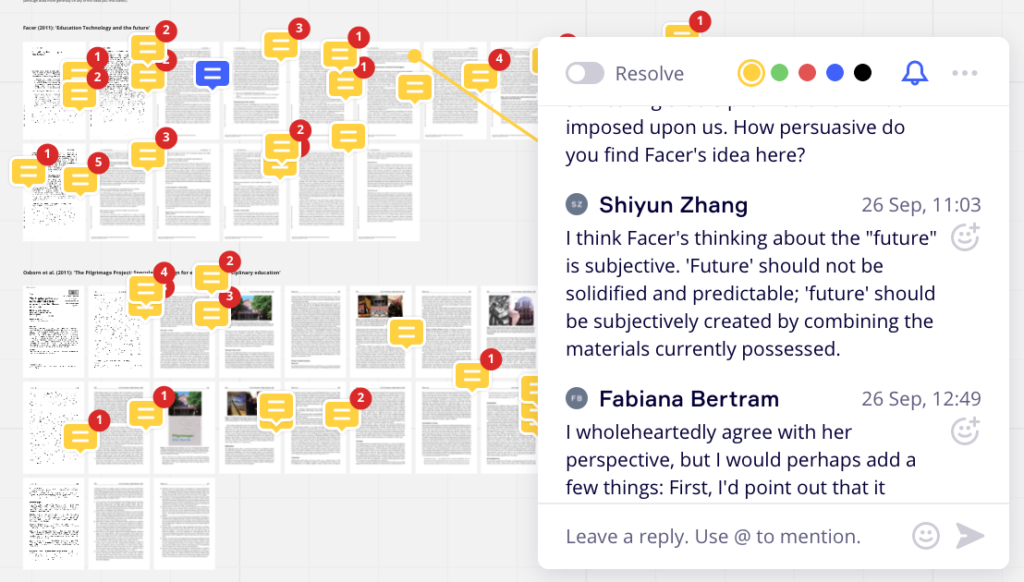
In this extra post, Dr James Lamb describes how he piloted an online, asynchronous tutorial activity, which supports a teaching model that is not bound to a fixed class time. James is co-programme director for MSc in Education Futures, and teaches on the MSc in Digital Education.
This semester, I’m teaching two courses: Learning Spaces and Digital Technologies (part of the MSc Digital Education) and The Future of Learning Organisations (MSc Education Futures). The former is a fully online course, while the latter is delivered in fusion mode, with students being able to attend on-site or online. With students participating from as far afield as Chile and China, and many undertaking their course while also working full-time, there’s a need for a teaching approach that isn’t tied to fixed class times. One approach that I’m sharing here is what I have come to describe as the ‘asynchronous tutorial’.
Asynchronous tutorial activity
This activity draws on the basic idea of the traditional tutorial (student discussion around course readings) but without trying to replicate the class-based exercise in an online setting. For each thematic block of the course, I add three core readings (journal articles or book chapters) to the collaborative whiteboard space of Miro. This is accompanied by a written commentary where I link the pieces together, and to the wider course. I then go through each of the readings, adding questions in the margin using Miro’s comment function. These critical prompts are there to nurture conversation, and I suppose they might be described a kind of interactive and collaborative marginalia.

As the name suggests, the asynchronous tutorial isn’t bound to the timetabled hour that can sometimes constrain classes (or limit attendance for those with competing professional and life commitments). Instead, students are able to join the conversation at any point across the week. They can also return at different points to see how discussion has evolved, and also to respond to questions that I or another member of group have directed at them (Miro automatically sends them an email notification when this happens). They can choose which prompts to respond to – I post questions that encourage discussion around theory, methods, practice and personal experience – and can also add their own conversation-starters where something captures their interest beyond what I’ve suggested. Activity ebbs and flows across the week as students dip into the tutorial as their other study, work and life commitments allow.
By the end of the week we’ve had a chance to get under the skin of each article – what I refer to as ‘working with the readings’ – while at the same being exposed to the ideas and experiences of other members of the group. On top of this, we will have also produced an artefact in its own right: a critical commentary in response to the original author’s work that sustains beyond the end of the tutorial. My use of ‘we’ is appropriate because I tend to become as immersed in the conversation as much as other members of the group.
The tutorial nominally ends when we move onto the next block of the course. However, there is no final round-up, and students can return to the artefact to add new ideas or to jog their memory when it comes to composing coursework. And, in fact, while writing this blog post, a student who missed a fortnight through illness has dropped into the tutorial she missed, and is currently adding to the conversation she couldn’t join at the time.

The feedback I’ve received so far has been positive. However, I’ll be paying close attention to the end of course surveys to see whether the wider group share this enthusiasm. What I can confidently say at this stage, though, is that the quality of discussion has been excellent, and that the asynchronous, online format has allowed for many more lines of conversation and contributions than would have been possible in more conventional sessions and spaces. This isn’t, of course, to say that every student has embraced the activity; there are still those who choose to watch from the edges, or not attend at all (so no different to a traditional tutorial, then). Meanwhile, while I see this approach as giving voice to those who normally lack the confidence to ‘speak up’ in class, or sometimes find it hard to assert themselves over more outwardly-assured peers, one student explained that she was reticent to “share ideas that might be wrong”. Perhaps I need to work even harder to advertise the speculative and supportive ethos behind the exercise.
Design considerations
A couple of other important design considerations. It takes around three hours to prepare each tutorial: that is, uploading the readings, writing the accompanying commentary and adding prompts in the margins. I doubt this sits well with the workload allocation models, but then again, the whole exercise dispenses with traditional conventions around timetabling and synchronous learning. It’s worth noting that this is the dominant teaching approach that I’m using therefore I think the prep time required is justified. Also important is that, while I’m using a University-supported Miro space and have deliberately avoided the many design functions that might reduce legibility, I’m keeping an eye on whether the approach presents accessibility problems.
I hope you’ve enjoyed reading about the asynchronous tutorial. The usual qualifications apply: this approach might suit some students and subjects better than others. All the same, the early signs are positive, and my instinct is that it offers students greater flexibility to contribute, and creates a space for really interesting and meaningful conversation.
 James Lamb
James Lamb
Dr James Lamb is co-programme director for MSc in Education Futures, and also teaches on the MSc in Digital Education. He researches and teaches around the relationship between learning spaces and digital technologies, and is a co-author of the Manifesto for Teaching Online (2020). Read more about James’ work at www.james858499.net.

